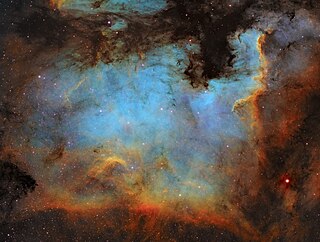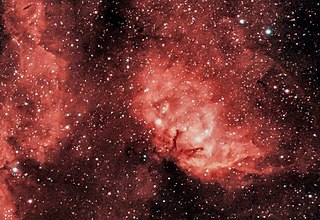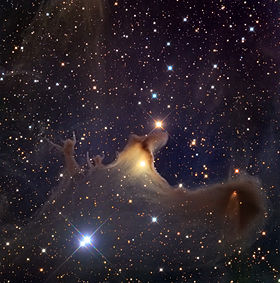
A nebula is a distinct luminescent part of interstellar medium, which can consist of ionized, neutral, or molecular hydrogen and also cosmic dust. Nebulae are often star-forming regions, such as in the "Pillars of Creation" in the Eagle Nebula. In these regions, the formations of gas, dust, and other materials "clump" together to form denser regions, which attract further matter and eventually become dense enough to form stars. The remaining material is then thought to form planets and other planetary system objects.

The Ring Nebula is a planetary nebula in the northern constellation of Lyra. Such a nebula is formed when a star, during the last stages of its evolution before becoming a white dwarf, expels a vast luminous envelope of ionized gas into the surrounding interstellar space.

The Orion Nebula is a diffuse nebula situated in the Milky Way, being south of Orion's Belt in the constellation of Orion, and is known as the middle "star" in the "sword" of Orion. It is one of the brightest nebulae and is visible to the naked eye in the night sky with apparent magnitude 4.0. It is 1,344 ± 20 light-years (412.1 ± 6.1 pc) away and is the closest region of massive star formation to Earth. The M42 nebula is estimated to be 24 light-years across. It has a mass of about 2,000 times that of the Sun. Older texts frequently refer to the Orion Nebula as the Great Nebula in Orion or the Great Orion Nebula.

NGC 2264 is the designation number of the New General Catalogue that identifies two astronomical objects as a single object: the Cone Nebula, and the Christmas Tree Cluster. Two other objects are within this designation but not officially included, the Snowflake Cluster, and the Fox Fur Nebula.

The Boomerang Nebula is a protoplanetary nebula located 5,000 light-years away from Earth in the constellation Centaurus. It is also known as the Bow Tie Nebula and catalogued as LEDA 3074547. The nebula's temperature is measured at 1 K making it the coolest natural place currently known in the Universe.

The Trifid Nebula is an H II region in the north-west of Sagittarius in a star-forming region in the Milky Way's Scutum-Centaurus Arm. It was discovered by Charles Messier on June 5, 1764. Its name means 'three-lobe'. The object is an unusual combination of an open cluster of stars, an emission nebula, a reflection nebula, and a dark nebula. Viewed through a small telescope, the Trifid Nebula is a bright and peculiar object, and is thus a perennial favorite of amateur astronomers.

The Tarantula Nebula is a large H II region in the Large Magellanic Cloud (LMC), forming its south-east corner.

The North America Nebula is an emission nebula in the constellation Cygnus, close to Deneb. It is named because its shape resembles North America.

The Lagoon Nebula is a giant interstellar cloud in the constellation Sagittarius. It is classified as an emission nebula and as an H II region.

Sh2-279 is an HII region and bright nebulae that includes a reflection nebula located in the constellation Orion. It is the northernmost part of the asterism known as Orion's Sword, lying 0.6° north of the Orion Nebula. The reflection nebula embedded in Sh2-279 is popularly known as the Running Man Nebula.

The Veil Nebula is a cloud of heated and ionized gas and dust in the constellation Cygnus.

NGC 2261 is a variable nebula located in the constellation Monoceros. The nebula is illuminated by the star R Monocerotis, which is not directly visible itself.

NGC 3242 is a planetary nebula located in the constellation Hydra.

The Water Lily Nebula, in the southern constellation of Ara, is a pre-planetary nebula also known as IRAS 16594-4656, in the process of developing to a planetary nebula. It is one of the pre-planetary nebulae containing polycyclic aromatic hydrocarbons, organic hydrocarbons otherwise constituting the basis for life.

Sh2-155 is a diffuse nebula in the constellation Cepheus, within a larger nebula complex containing emission, reflection, and dark nebulosity. It is widely known as the Cave Nebula, though that name was applied earlier to Ced 201, a different nebula in Cepheus. Sh2-155 is an ionized H II region with ongoing star formation activity, at an estimated distance of 725 parsecs from Earth.

NGC 2359 is an emission nebula in the constellation Canis Major. The nebula is approximately 3,670 parsecs away and 30 light-years in size. The central star is the Wolf-Rayet star WR7, an extremely hot star thought to be in a brief pre-supernova stage of evolution. It is similar in nature to the Bubble Nebula, but interactions with a nearby large molecular cloud are thought to have contributed to the more complex shape and curved bow-shock structure of Thor's Helmet.

Sharpless 101 (Sh2-101) is a H II region emission nebula located in the constellation Cygnus. It is sometimes also called the Tulip Nebula because it appears to resemble the outline of a tulip when imaged photographically. It was catalogued by astronomer Stewart Sharpless in his 1959 catalog of nebulae. It lies at a distance of about 6,000 light-years (5.7×1016 km; 3.5×1016 mi) from Earth.

NGC 1931 is an emission and reflection nebula in the constellation Auriga. The nebula has been referred to as a "miniature version of the Orion Nebula", as it shares some of the same characteristics. It is a mixed emission-reflection nebula, and contains a smaller version of the Trapezium in its hot young star cluster centered in the emission nebula. The entire cluster/nebula complex is only about 3 arcmin in size. The distance from earth is estimated at about 7000 light years.

Little Ghost Nebula, also known as NGC 6369, is a planetary nebula in the constellation Ophiuchus. It was discovered by William Herschel.

Sh2-54 is an extended bright nebula in the constellation of Serpens.




















